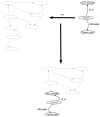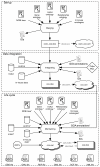The Cell Cycle Ontology: an application ontology for the representation and integrated analysis of the cell cycle process
- PMID: 19480664
- PMCID: PMC2718524
- DOI: 10.1186/gb-2009-10-5-r58
The Cell Cycle Ontology: an application ontology for the representation and integrated analysis of the cell cycle process
Abstract
The Cell Cycle Ontology (http://www.CellCycleOntology.org) is an application ontology that automatically captures and integrates detailed knowledge on the cell cycle process. Cell Cycle Ontology is enabled by semantic web technologies, and is accessible via the web for browsing, visualizing, advanced querying, and computational reasoning. Cell Cycle Ontology facilitates a detailed analysis of cell cycle-related molecular network components. Through querying and automated reasoning, it may provide new hypotheses to help steer a systems biology approach to biological network building.
Figures







Similar articles
-
FYPO: the fission yeast phenotype ontology.Bioinformatics. 2013 Jul 1;29(13):1671-8. doi: 10.1093/bioinformatics/btt266. Epub 2013 May 8. Bioinformatics. 2013. PMID: 23658422 Free PMC article.
-
Textpresso: an ontology-based information retrieval and extraction system for biological literature.PLoS Biol. 2004 Nov;2(11):e309. doi: 10.1371/journal.pbio.0020309. Epub 2004 Sep 21. PLoS Biol. 2004. PMID: 15383839 Free PMC article.
-
CelOWS: an ontology based framework for the provision of semantic web services related to biological models.J Biomed Inform. 2010 Feb;43(1):125-36. doi: 10.1016/j.jbi.2009.08.008. Epub 2009 Aug 18. J Biomed Inform. 2010. PMID: 19695346
-
Cell cycle regulation in the yeasts Saccharomyces cerevisiae and Schizosaccharomyces pombe.Annu Rev Cell Biol. 1991;7:227-56. doi: 10.1146/annurev.cb.07.110191.001303. Annu Rev Cell Biol. 1991. PMID: 1809348 Review. No abstract available.
-
Cell cycle molecules and mechanisms of the budding and fission yeasts.Methods Mol Biol. 2005;296:3-29. doi: 10.1385/1-59259-857-9:003. Methods Mol Biol. 2005. PMID: 15576924 Review.
Cited by
-
Linking genome annotation projects with genetic disorders using ontologies.J Med Syst. 2012 Nov;36 Suppl 1:S11-23. doi: 10.1007/s10916-012-9890-7. J Med Syst. 2012. PMID: 23149630
-
The 3rd DBCLS BioHackathon: improving life science data integration with Semantic Web technologies.J Biomed Semantics. 2013 Feb 11;4(1):6. doi: 10.1186/2041-1480-4-6. J Biomed Semantics. 2013. PMID: 23398680 Free PMC article.
-
Current trends and new challenges of databases and web applications for systems driven biological research.Front Physiol. 2010 Dec 3;1:147. doi: 10.3389/fphys.2010.00147. eCollection 2010. Front Physiol. 2010. PMID: 21423387 Free PMC article.
-
Capturing domain knowledge from multiple sources: the rare bone disorders use case.J Biomed Semantics. 2015 Apr 17;6:21. doi: 10.1186/s13326-015-0008-2. eCollection 2015. J Biomed Semantics. 2015. PMID: 25926964 Free PMC article.
-
Discovery of Emerging Design Patterns in Ontologies Using Tree Mining.Semant Web. 2018;9(4):517-544. doi: 10.3233/SW-170280. Epub 2018 Jun 29. Semant Web. 2018. PMID: 30505251 Free PMC article.
References
-
- Le Novère N, Bornstein B, Broicher A, Courtot M, Donizelli M, Dharuri H, Li L, Sauro H, Schilstra M, Shapiro B, Snoep JL, Hucka M. BioModels Database: a free, centralized database of curated, published, quantitative kinetic models of biochemical and cellular systems. Nucleic Acids Res. 2006;34:D689–691. - PMC - PubMed
-
- Ng A, Bursteinas B, Gao Q, Mollison E, Zvelebil M. Resources for integrative systems biology: from data through databases to networks and dynamic system models. Brief Bioinform. 2006;7:318–330. - PubMed
Publication types
MeSH terms
LinkOut - more resources
Full Text Sources
Molecular Biology Databases

